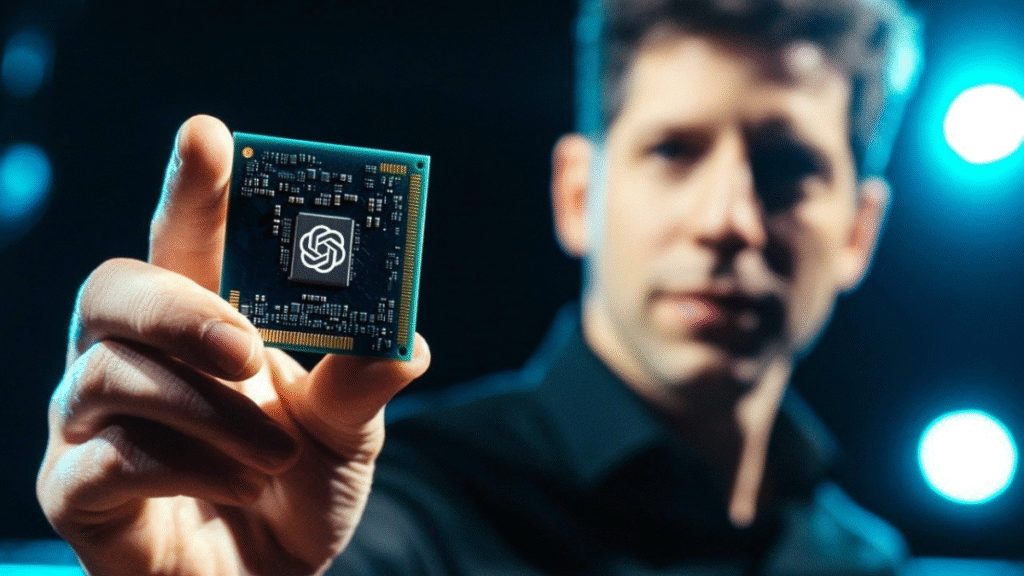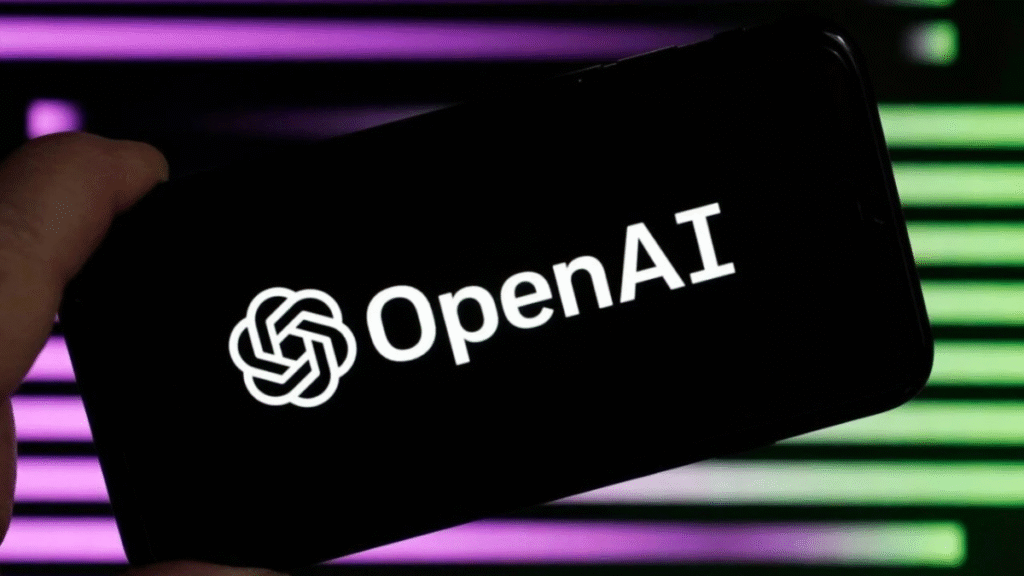OpenAI is set to make waves in the tech world. The company plans to launch its first AI chip in 2026. This ambitious move is in collaboration with Broadcom, a leader in semiconductor technology.
The AI chip marks OpenAI’s entry into the hardware market. It aims to enhance AI model performance and reduce reliance on third-party hardware. This development is a strategic shift for OpenAI, aligning with trends in AI specialization.
The collaboration with Broadcom is crucial. It leverages Broadcom’s expertise in semiconductor design and manufacturing. This partnership is expected to lead to significant innovations in AI hardware.
The launch of OpenAI’s AI chip is a major event in tech news. It could redefine the competitive landscape of AI technology. The chip is anticipated to be a game-changer, setting new standards for AI hardware performance.

OpenAI’s Strategic Move into AI Hardware
OpenAI’s decision to develop its own AI chip is a bold move. This shift represents a significant investment in hardware. It shows OpenAI’s commitment to advancing AI technology.
The choice to enter the hardware market is driven by several factors. Primarily, OpenAI aims to enhance the scalability of its AI models. By creating custom hardware, they can better meet the needs of modern AI applications. This approach also provides more control over AI infrastructure.
Reducing dependency on third-party providers is another goal. By building their own chips, OpenAI can tailor solutions to specific computational demands. This step could lead to cost reductions and improved efficiencies in AI operations.
OpenAI’s move is aligned with industry trends. Many tech giants are investing in custom chips. This strategy can offer competitive advantages in performance and energy efficiency. It can also push the boundaries of innovation in AI applications.
The new AI chip is expected to play a pivotal role. It will likely support OpenAI’s future AI models, enabling advanced capabilities. This development is part of OpenAI’s broader strategy to lead in AI research and technology.
Overall, this initiative reflects OpenAI’s long-term vision. It’s a strategic effort to control and innovate within the AI infrastructure space. By investing in hardware, OpenAI seeks to solidify its position as a leader in the AI industry.
The OpenAI-Broadcom Partnership: What We Know
OpenAI’s collaboration with Broadcom is a significant development. This partnership combines OpenAI’s AI expertise with Broadcom’s semiconductor knowledge. It sets a foundation for creating cutting-edge AI hardware.
The details of the collaboration reveal strategic objectives. OpenAI seeks to leverage Broadcom’s industry experience to design a high-performance AI chip. This effort aims to ensure that the chip meets the demands of OpenAI’s AI models. The partnership highlights the importance of synergy in tech innovation.
A few key aspects of the partnership include:
- Broadcom’s role in chip manufacturing
- Joint research and development efforts
- Focus on energy-efficient design
- Commitment to rapid project timelines
The choice of Broadcom is strategic. Broadcom is known for its robust capabilities in chip design and production. Their involvement is crucial to the AI chip’s success. This collaboration underscores the importance of aligning with established industry leaders.
This joint venture may lead to further collaborations. It opens doors for potential future projects between the two companies. Such partnerships are likely to drive significant advancements in AI hardware development.
Overall, the OpenAI-Broadcom partnership is a pivotal element of OpenAI’s new hardware strategy. It demonstrates OpenAI’s commitment to pioneering technology by collaborating with industry leaders. The outcome of this partnership is eagerly anticipated by industry watchers.
Why OpenAI Is Building Its Own AI Chip
OpenAI’s decision to create its own AI chip marks a strategic pivot. The primary aim is to enhance the capabilities and efficiency of AI models. By building custom hardware, OpenAI can tailor the chip to its specific needs.
A custom AI chip allows OpenAI to optimize performance. It reduces reliance on third-party hardware providers, enhancing control over technology development. This autonomy is crucial as AI models grow in complexity and demand greater computational resources.
Several reasons underline this decision:
- Increase efficiency and speed of AI tasks
- Reduce costs associated with third-party hardware
- Customize hardware to fit OpenAI’s unique AI models
- Enhance energy efficiency of AI operations
The move aligns with industry trends. Many tech companies are now developing proprietary chips. This approach helps them gain competitive advantages. It allows for more seamless integration of AI hardware and software.
Ultimately, the initiative supports OpenAI’s broader goal. By advancing AI infrastructure, OpenAI aims to remain at the forefront of AI development. Crafting its own AI chip is a significant step in achieving this vision.
Features and Capabilities of the Upcoming AI Chip
OpenAI’s forthcoming AI chip promises to bring several cutting-edge features to the table. Designed specifically for AI applications, it aims to set new performance benchmarks. The chip is engineered to handle complex computations at impressive speeds.

Energy efficiency is a key focus of this development. OpenAI’s chip is expected to consume less power while delivering high performance. This will make it suitable for large-scale AI operations in data centers.
The chip’s architecture is built to optimize AI model processing. It supports a wide range of AI frameworks, making it highly versatile. This compatibility ensures seamless integration with existing AI systems.
Here are some notable features:
- High computational speed for complex AI tasks
- Enhanced energy efficiency for sustainable operations
- Wide compatibility with current AI frameworks
- Robust architecture supporting large-scale data processing
This custom hardware is designed to meet rising AI demands. By optimizing data throughput, it allows for quicker model training and deployment. This can significantly reduce time-to-market for new AI innovations.
These advancements could revolutionize AI applications across industries. From healthcare to finance, the chip’s capabilities can enhance the speed and accuracy of AI solutions. OpenAI’s new hardware venture truly aims to push the boundaries of AI technology forward.
Impact on the AI and Semiconductor Industries
The introduction of OpenAI’s AI chip is set to influence both the AI and semiconductor sectors significantly. This development marks OpenAI’s foray into hardware, likely altering existing industry dynamics. Such a move could spur further innovation across these fields.
The AI industry’s growth could accelerate with the chip’s performance enhancements. Faster processing and improved energy use may enhance AI system efficiency. This might enable more sophisticated AI applications in diverse areas such as healthcare and autonomous vehicles.
In the semiconductor industry, OpenAI’s collaboration with Broadcom highlights the importance of partnerships. It underscores the trend of tech firms developing specialized hardware. This could lead to a wave of new alliances focused on custom AI chips.
Key impacts include:
- Enhanced AI application efficiency
- Increased demand for AI-specific hardware
- Growth in tech partnerships for chip development
- Shifts in industry competition dynamics
by rc.xyz NFT gallery (https://unsplash.com/@moneyphotos)
The chip might also push competitors to innovate faster. Companies may invest more in research to keep up with these new benchmarks. Hence, OpenAI’s move could accelerate technological progress, reshaping the future of AI and semiconductors profoundly.
Business Implications and Market Reactions
OpenAI’s entry into the hardware sector signifies a strategic business shift. This move promises to enhance the firm’s AI service offerings. It could also yield significant cost savings by reducing reliance on third-party hardware.
The AI chip’s potential to lower operational costs is likely to attract investors. Increased efficiency could improve profit margins for businesses leveraging OpenAI’s technology. This economic benefit may prompt more companies to adopt AI solutions.
Market reactions have been mixed but generally optimistic. Investors see the collaboration with Broadcom as a strength. It signifies reliability in the production of high-performance chips. However, some analysts express cautious optimism, noting potential production risks.
Key business implications include:
- Reduced hardware costs for OpenAI
- Increased interest from tech investors
- Enhanced competitiveness in AI services
- Potential impact on hardware suppliers
Initial market responses also indicate a rise in OpenAI’s brand valuation. As the 2026 launch date approaches, further market volatility is anticipated. Observers will watch how OpenAI manages challenges, influencing future confidence in the brand.
How OpenAI’s Chip Could Change AI Development
OpenAI’s upcoming AI chip has the potential to significantly influence AI development. The chip aims to enhance AI processing capabilities. This technological innovation can lead to notable improvements in AI model performance.
The chip could provide better support for complex algorithms. This is important as AI tasks grow more demanding. Faster processing times and improved efficiency make larger-scale AI projects feasible. Developers will be able to push boundaries with fewer constraints.
The unique design of the chip focuses on optimizing AI operations. Specialized hardware could allow for more accurate models. This paves the way for groundbreaking AI applications across various domains.
Key potential changes in AI development include:
- Improved processing speed and efficiency
- Enhanced support for complex AI algorithms
- Broader application potential in diverse fields
- Greater scalability for extensive AI projects
In essence, OpenAI’s chip might redefine benchmarks in AI research. It offers new possibilities for innovation, shaping the future of AI development in unprecedented ways. The effects could resonate across industries relying on AI technology.
Challenges and Risks Ahead
While OpenAI’s AI chip presents exciting prospects, it also faces several challenges and risks. Developing cutting-edge hardware requires substantial investment and innovation. There’s a significant financial risk involved.
The complexity of chip design is another hurdle. Ensuring compatibility with existing systems is essential. This entails rigorous testing and refinement processes, which can be time-consuming.
Manufacturing capabilities must meet high standards. Any production delays could impact launch timelines. OpenAI needs to mitigate risks associated with supply chain disruptions.
Key challenges include:
- High development costs
- Complex design and testing requirements
- Manufacturing and supply chain risks
Navigating these issues successfully is crucial for OpenAI. Addressing potential pitfalls early on can ensure a smoother path to success. OpenAI’s ability to handle these obstacles will define its journey into AI hardware.
What This Means for the Future of AI
OpenAI’s development of its own AI chip signals a pivotal shift in the artificial intelligence landscape. This move could encourage other companies to consider customizing their hardware. Such a trend may lead to a new wave of innovation in AI technology.
With customized chips, AI models can achieve greater efficiencies. This could result in faster, more powerful AI applications. As a result, industries employing AI might experience transformative changes in their operations.
By investing in specialized hardware, OpenAI sets the stage for future advancements. Their initiative could push boundaries and inspire further development in AI research. This marks a crucial step toward deeper integration of AI into daily life.
Conclusion: A New Era for OpenAI and AI Hardware
OpenAI’s foray into hardware heralds a significant milestone in its journey. By launching its AI chip in 2026, OpenAI aims to redefine AI capabilities and influence the tech sector.
The collaboration with Broadcom underlines the value of strategic partnerships in advancing technology. As OpenAI embarks on this new path, it sets the stage for enhanced AI innovation and opportunity. This pivotal move promises to reshape the landscape of artificial intelligence.
Discover more – The smartphone market is evolving rapidly, and brands are racing to deliver powerful devices with modern design and cutting-edge technology… Read More

